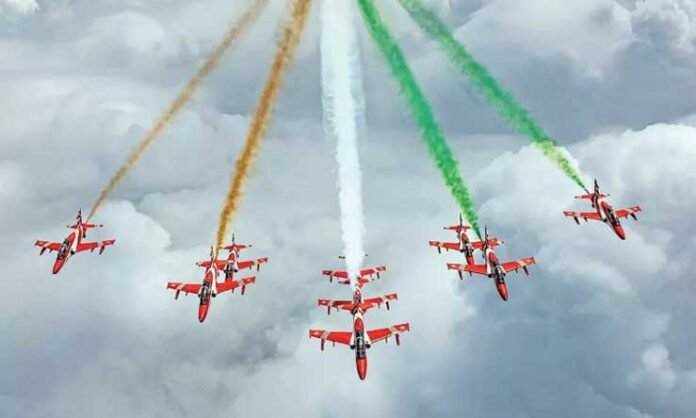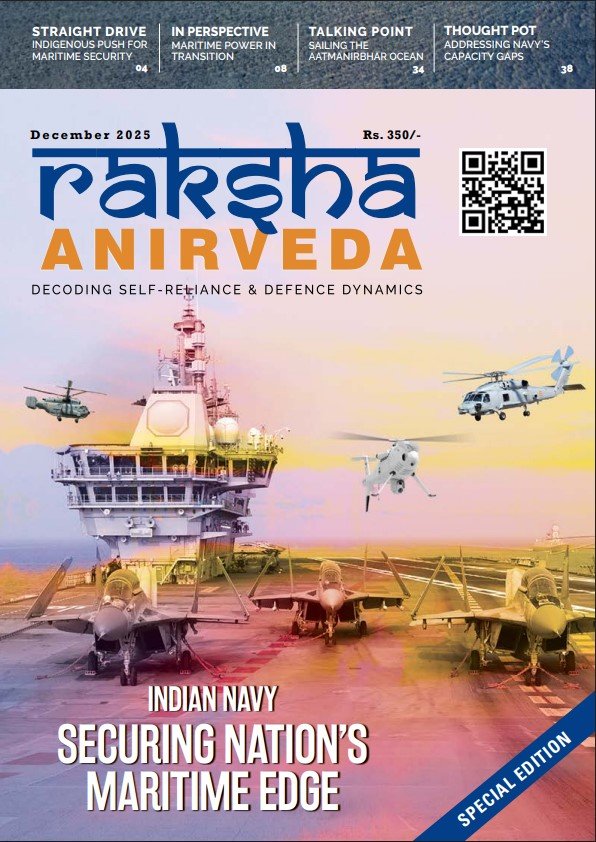The aerospace industry accounts for nearly 40 percent of global military expenditure which was $2.24 trillion in 2022. India already is a major global aerospace market. Indian Armed Forces have increasing defence aerospace requirements and budgets. Coupled with this, India also has a booming commercial aviation market. But, unfortunately, India continues to be one of the largest importer of aviation products.
Aviation technologies are always the leading and cutting edge, and often game changers. They add deterrent capabilities to every nation’s defence might. Similarly, the aerospace industry involves development, production and maintenance of aircraft, missiles, and UAVs. It also needs many airborne systems, avionics, aero-engines, rockets, and weapons. These require continuous investments in research and development, as obsolescence sets in faster in these domains. For India to become a global player, it must become self-sufficient in defence and aerospace domains. For India to sit on the global high table, it must develop its prowess in some of these domains.
The Defence Research and Development Organisation (DRDO), the Hindustan Aeronautics Ltd (HAL), other Defence Public Sector Undertakings (DPSU) and private sector defence industry have seen a rise in technological and manufacturing capabilities in India. Further, India has added advantage of higher skills and lower costs of production. The present government’s Aatmanirbharta push, supports the ‘Make in India’ paradigm. Time is ripe for developing new technologies and boosting domestic defence production. Artificial intelligence (AI) and Information Technology will support the process of indigenisation.
The aerospace industry accounts for nearly 40 percent of global military expenditure which was $2.24 trillion in 2022. India already is a major global aerospace market
India’s Huge Military Aviation Requirements
Indian Armed Forces requires many types of fighter aircraft, transport crafts and helicopters. Yet, the IAF still requires 114 imported fighters to make good the gap between demand and supply. India will soon procure the General Atomics’ Predator MQ-9 UAVs. In addition, it requires additional Flight Refuelling Aircraft (FRA), Airborne Early Warning and Control (AEW&C) aircraft, drones, among others. There is a need for air defence radars, missiles systems, long range precision aerial weapons, and much more. Yet, India remains dependent for foreign help in manufacturing aero-engines, many avionics, radars, some weapons, and ejection seats, among others.

HAL: Heavily Committed
HAL is the leading Indian aerospace company with 19 production units. It has manufactured 26 different types of aircraft so far, mostly for the IAF, through indigenous development and licence-production deals. HAL license-produced fighters like Su-30 MKI, medium transport aircraft, trainers, and helicopters. HAL has also built both Russian and Western aero-engines under license. It is all set now to manufacture GE 414 engines in India. HAL also supplies components to major global companies’ such as Airbus, Boeing, and Eurocopter among others. HAL’s composite manufacturing capability is world class. But HAL has potential to do still better in human productivity and quality assurance.
HAL will soon complete deliveries of 40 Light Combat Aircraft (LCA) ‘Tejas’ Mk1. 83 LCA Mk1A with modern AESA radar are under production, and their delayed will start from November 2024. IAF has committed to manufacture additional 100 Mk1A recently. HAL is also working on LCA Mk2 with the more powerful GE 414 engine, now called the Medium Weight Fighter. The first flight of Mk2 is planned in 2024, and induction around 2032. IAF needs around 200 LCA Mk2. IAF also awaits the indigenous, HAL-DRDO’s fifth-generation stealth Advanced Medium Combat Aircraft (AMCA). This is a work still in initial stages and the aircraft may fly around 2028 and be induct around 2035.
Aviation technologies are always the leading and cutting edge, and often game changers. They add deterrent capabilities to every nation’s defence might
India has done well in helicopter production. Nearly 400 Advanced Light Helicopter (ALH), ALH-WSI ‘Rudra’, the Light Combat Helicopter (LCH) ‘Prachand’ and Light Utility Helicopter (LUH) are already flying. HAL is also developing Indian Multi Role Helicopter (IMRH). Meanwhile the NAL-HAL Saras continues to be developed slowly.
DRDO: Great Potential, Needs to Harness Aviation Technology
Many of DRDO’s 52 laboratories run aviation technology projects. These include aeronautics programmes, unmanned aerial vehicles, missiles and other weapons including lasers, precision-guided munition, glide bombs, electronic warfare, and the Hypersonic Technology Demonstrator Vehicle (HSTDV). There is a Defence Technology Commission with the defence minister as its chairman.

What matters for defence preparedness is the R&D systems that gets inducted into the armed forces. The DRDO-developed products which have been inducted include the LCA, Akash AD missile system, Sukhoi Su-30MKI avionics, the Tarang radar warning receiver, Lakshya PTA, Retarder bomb kits, Netra AEW&C, series of surveillance and missile control radars, Prithvi and Agni series of missiles, Helina ATGM, BRAHMOS and Nirbhay cruise missiles, Astra AAM, the ABM project’s AAD (Advanced Air Defence) and PAD (Prithvi Air Defence) missiles.
Among the ongoing projects are DRDO/HAL AMCA, Rustom, TAPAS-BH-201 and AURA UAV, missile approach warning system (MAWS), Multi-role radar ‘Uttam’ for LCA, laser and directed energy weapons (DEW), FLIR and Wide angle HUDs, Barak 8 LRSAM, NGARM (New Generation Anti-Radiation Missile) Rudram-1, ASAT capability enhancement, Sudarshan Laser guided bomb, Garuthmaa & Garudaa 1000 kg Glide Bombs, Smart Anti-Airfield Weapon (SAAW), High Speed Low Drag Bomb, Solid Fuel Ducted Ramjet (SFDR) and GTX-35VS Kaveri engine, among few others. DRDO is also converting six pre-owned airliners into AEW&C and FRA aircraft for IAF. IAF has also ordered six more ‘Netra’ AEW&C. These needs hastening.
Though the infrastructure is in place, and there has been significant success in the LCA program, missiles, and radars. Yet, in many other areas, it is work still in progress. The committee set up for ‘restructuring and redefining’ role of DRDO under the former Principal Scientific Advisor to government, K Vijay Raghavan has submitted its report, and action on the same is still awaited.
The present government’s ‘Aatmanirbharta’ push, supports the ‘Make in India’ paradigm. Time is ripe for developing new technologies and boosting domestic defence production
Private Industry Becoming Significant
Private sector has finally started entering aerospace domain in a big way. The Indian conglomerate – Tata, set up an aerospace production facility in Hyderabad, named TASL. They are manufacturing aero-structures for CH-47 Chinook, AH-64 Apache, S-92 helicopters, C-130 Hercules, and for the Pilatus PC-12NG. They also make wings for F-16s Akash SAM launchers. TASL is poised to produce CASA C-295 MW transport aircraft, and will soon start producing UAVs and kamikaze drones, too.
Dynamatic Technologies makes assemblies of vertical fins for Sukhoi 30 MKI fighters, and also supplies aero-structures for Airbus aircraft. Hyderabad-based VEM technologies manufactures central-fuselage for LCA Tejas. Many Indian MSMEs and start-ups are active in defence production sector.

UAVs and Drones
Indian armed forces have a huge requirement of large and medium UAVs. Thus, developing the Manned-Unmanned Aircraft Teaming (MUMT) is an area of action. Adani Elbit Advanced Systems India Limited is producing Hermes-900 UAVs in India. Many start-ups have entered drones and counter-drone manufacturing sector. These include Newspace Research & Technologies, Paras Aerospace, Veda Aeronautics, Throttle Aerospace, General Aeronautics, Redwing Labs, Dhaksha Unmanned Systems, UrbanMatrix Technologies, Thanos Technologies, and Auto Micro UAS, among many others.
HAL is the leading Indian aerospace company with 19 production units. It has manufactured 26 different types of aircrafts so far, mostly for the IAF
Need to Harness New Aviation Technologies
India needs to cover a lot of distance on developing aero-engines, stealth and network-centric systems, advanced multifunction AESA radars, Infra-Red Search and Tracking (IRST), electronic warfare, Directed Energy Weapons (DEW), hypersonic platforms and weapons, and Artificial Intelligence (AI) secure communications, among others. However, the Aero-engine and hypersonic development programmes require a task force like approach to achieve early results.
Advanced Long Range Precision Weapons
Air engagements are becoming broader and complex, there is thus a need for developing long range sensors and weapons that can operate in adverse electronic environment. Precision and range are the two critical requirements for both air-to-air and air-to-surface weapons. India has a successful missile programme, including the Astra, Akash, BrahMos, among others. Astra Mk 3, and BrahMos II projects need to be accelerated. In many cases we have partnered with Russia and Israel for coproduction. The JV route is working well. Gradually, critical components like weapon sensor heads and control systems must be increasingly produced by India, as DEWs allow ‘high off bore sight’ and even rear hemisphere kills and ‘lower cost per kill’.
Harnessing Space
Space is the ultimate vantage point and future for all action and capabilities, besides being the real force multiplier. Space is the enabler for most ISR, communications, and navigation, and targeting capabilities on earth. Air and space domains have already begun to be merged and need to be exploited together. For the success of any surface or sub-surface campaign, aerospace superiority would be the starting point.
Though the infrastructure is in place, and there has been significant success in the LCA programme, missiles, and radar manufacturing. Yet, in many other areas, it is work still in progress
India needs to build and secure its assets in space. China has moved significantly ahead in this regard. Their number of launches, satellites and constellations, space-station, and satellite navigation systems are way ahead of India.
Though, India possesses most space-development capabilities. Only the numbers need to be increased for better redundancy, and higher revisit for ISR. Also, India must quickly operationalise its satellite navigations system Navic. IAF is best placed to harness space for its networked operations and Integrated Air Command and Control System (IACCS). Ultimately the space must be merged with air for better exploitation of these two contiguous domains that have great commonality.

Way Forward
IAF is already facing depletion in numbers of fighter squadrons. Modernisation programmes are running behind schedule. Going forward, indigenous production has to be ramped up in terms of quality, numbers and deliveries on time. India is still at LCA Mk1 stage. Other variants are yet to come. The AMCA may require foreign help for some technologies. HAL still has production and quality issues to resolve. HAL platforms continue to be import dependent and therefore costly. In addition, manpower productivity must also increase.
India needs to cover a lot of distance on developing aero-engines, stealth and network-centric systems, advanced multifunction AESA radars, Infra-Red Search and Tracking and electronic warfare systems
Long project delays force revision of service air staff requirements, as technologies moves ahead quickly. More efficient corporate structure may help in this regard, and the PSUs must be released from bureaucratic control. China and India are still evolving their engine design and manufacturing abilities. India has been dependent on Russian, French and American engines for long. As there are only a handful of major aircraft engine manufacturers in the world, India needs to engage with them proactively.
India should not have to import trainer aircraft. India also does not have a significant transport aircraft project. India also needs help in advanced AESA radars, EW systems, modern weapons, Artificial Intelligence (AI) and other advanced avionics. It is best to adopt a collaborative approach and use economic muscle and high military systems requirements to seek transfer of technology to produce more indigenously. The Prime Minister has given a clear direction for developing a Aatmanirbhar Bharat. India needs to think ahead, and harness its numbers, lest we get left behind.
–The writer is a IAF veteran (PVSM AVSM VM VSM) and former Director-General, Centre for Air Power Studies (CAPS). The views expressed are of the writer and do not necessarily reflect the views of Raksha Anirveda






